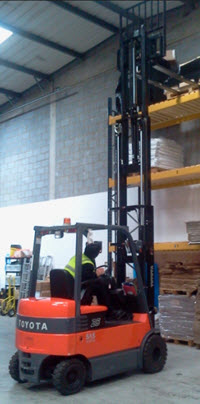The whole body vibration (WBV) is the vibration, shaking or jolting of the body transmitted through a supporting surface. In the case of a forklift truck, vibration is transmitted from your forklift seat, floor or back rest. WBV is known to cause a number of health issues, including shoulder and knee pain, whiplash and musculoskeletal injury of which the most common is lower back pain. WBV can also aggravate an existing conditions.
The causes of the vibration in a forklift truck are:

- Engine vibration
- Solid tyres unable to absorb road/surface vibrations unlike cars and other road vehicles
- Road surface
- Speed the forklift truck is travelling at.
- Load distribution
- Forklift Seat Suspension
- Maintenance of the forklift truck
There are certain steps you can take to reduce WBV on a forklift truck. These include:
- Battery powered forklift trucks generate less vibrations than internal combustion engine powered ones. If you have an option of more than one forklift truck operating at a site and one is battery powered, than the operators can be rotated so that all the operators have a share of using the forklift truck with lower vibrations
- Ensure road surfaces are as even as possible. Fill in pot holes. If you can, change the route of the forklift truck so that it traverses over the most even road surfaces
- Reduce the speed of the forklift truck as lower speeds generate lower vibrations.
- Starting and stopping should be as smooth as possible.
- Load the forklift truck as evenly as possible as uneven load distribution increases vibrations
- Air suspension seat is more effective in attenuating the forklift truck vibrations than mechanical suspension
- If possible use softer tyres that can absorb some of the vibrations
- Regularly maintain the forklift truck
There are ways a forklift operator can mitigate some of the injury risks from WBV. These include:
- Taking frequent breaks
- Although sitting long periods is part of the job for most forklift operators, do stretching exercises when you can in the cab of the forklift truck including neck and surrounding muscles
- Readjust your seat so that your feet rest comfortably and you should be able to easily reach the steering wheel, pedals and hydraulic controls
- Use your seat’s backrest to take pressure of your back
- Do not have your wallet in your back pocket as this may cause you strain
- If possible use a seat with arm rests
- Use correct posture while sitting. Do not slouch
- If you are prone to back issues, use a brace when driving a forklift truck
Office for National Statistics reports that in 2016, the number of days lost due to musculoskeletal problems (including back pain, neck and upper limb problems) was 30.8 million. This is 22.4% of all working days lost in UK due to sickness.
It is in the interest of the company and the forklift truck operator to minimise the risk of WBV.
Wallace School of Transport including Forklift Training in London is a fully accredited RTITB company with over 60 years’ experience. You can be trained either at your own work site or at Wallace Centre in Park Royal. If you have any questions, call Wallace Forklift Training on 020 8453 3440, choose option 3 or click here to email us.
